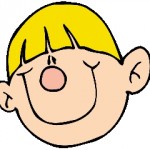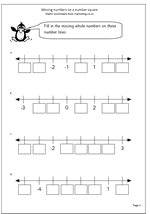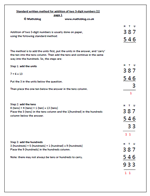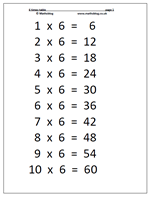 Let’s continue by looking at the expectations for children at the end of year 2 (6 to 7 years old). This is a year where a huge amount of new maths is introduced. However, it is still important to keep the maths in a practical context using real life situations. One of the most important developments is that children are expected to work with larger numbers, up to 100 and whole hundreds. Partitioning (or splitting numbers) is introduced with questions such as 36 = ? + 6.
Let’s continue by looking at the expectations for children at the end of year 2 (6 to 7 years old). This is a year where a huge amount of new maths is introduced. However, it is still important to keep the maths in a practical context using real life situations. One of the most important developments is that children are expected to work with larger numbers, up to 100 and whole hundreds. Partitioning (or splitting numbers) is introduced with questions such as 36 = ? + 6.
Remember to look at the year 1 expectations to see the progression.
Counting and understanding number:
By the end of year 2 children should
• be able to read and write 2-digit numbers in figures and words.
(eg read ‘thirty six’.)
• be able to read and write 3-digit numbers in figures and words.
(eg read ‘360’.)
• be able to continue number sequences by counting on and back in steps of 1, 10 or 100.
(eg count on in tens from 50 to 100.)
• be able to recognise odd and even numbers.
(eg which of these numbers is odd 8, 9, 10 ?)
• be able to count up to 100 objects, by grouping them into tens.
• be able to group objects into twos and fives.
• understand place value. Children should know what each digit in a 2-digit number represents.
(eg the 2 in 27 represents 20.)
• through an understanding of place value, be able to partition a 2-digit number.
(eg 54 = 50 and 4 or 54 = 40 + 14.)
• be able to compare two numbers, saying which is more or less.
(eg which is more 27 or 72?)
• be able to put 4 or 5 numbers in order, largest/smallest first.
(eg put these numbers in order, smallest first: 6, 3, 9, 1.)
• be able to position a 2-digit number on a number line.
• understand two new signs: the greater than (>) and less than (<) signs.
• develop the language of estimation to include: roughly, nearly, close to, about the same as, estimate, too many, too few, enough, not enough.
• be able to make estimates of numbers up to about 50.
(eg the number of potatoes on a shelf.)
• round a number to the nearest ten.
(eg is page 43 in a book is closer to page 40 or page 50?)
• develop their vocabulary for fractions, recognising ½ and ¼ .
• be able to find half and find quarters of shapes and sets of objects.
Knowing and using number facts:
By the end of year 2 children should
• know all addition facts for two numbers up to a total of 10.
(eg 4 + 5.)
• be able to derive subtraction facts for numbers up to 10.
(eg if they know that 6 + 3 = 9, they can instantly work out that 9 – 6 = 3.)
• know all the pairs of whole numbers which total 20.
(eg 16 + 4.)
• know all the pairs of multiples of 10 which total 100.
(eg 30 + 70.)
• know the doubles of whole numbers up to a total of 20.
(eg double 7.)
• understand that halving is the inverse of doubling and hence derive halving facts from their knowledge of doubling.
(eg if double 8 is 16, then half 16 is 8.)
• recall 2, 5 and 10 times-tables.
(eg know 5 x 6.)
• work out related division facts.
(eg if 5 times 2 is 10, then 10 divided by 5 is 2.)
• be estimating answers to calculations and checking their answers by using the inverse operation.
Calculating:
By the end of year 2 children should
• be able to mentally add a single digit to any 2-digit number.
(eg 24 + 5.)
• be able to mentally add a single digit to a multiple of 10.
(eg 30 + 9.)
• be able to add a multiple of 10 to any 2-digit number.
(eg 34 + 50.)
• be able to mentally subtract a single digit from any 2-digit number.
(eg 44 – 5.)
• be able to mentally subtract a multiple of 10 from any 2-digit number.
(eg 43 – 20.)
• be using practical and informal methods to add or subtract two 2-digit numbers. This means making their own jottings rather than the standard written method.
• by understanding that subtraction is the inverse of addition, be able to work out related addition and subtraction sentences.
(eg if 9 + 5 = 14, then 5 + 9 = 14, 14 – 5 = 9 and 14 – 9 = 5.)
• be able to recognise multiplication as repeated addition.
(eg 4 added together 3 times is 4 + 4 + 4, or 3 lots of 4, or 3 times 4, or 3 x 4.)
• also be able to represent multiplication as an array
eg
3 x 2 = 6
2 x 3 = 6
• recognise division as sharing.
(eg share 8 sweets between 2 children.)
• recognise division as grouping.
(eg there are 12 sweets in a bag. How many bags of 3 sweets can be filled?)
• recognise all four symbols +, -, x and ÷ and use them in number sentences.
Understanding shape:
By the end of year 2 children should
• be able to visualise 2-D shapes and 3-D solids. (See earlier years for vocabulary).
• be able to identify shapes from pictures in different orientations.
• be able to make shapes and patterns with increasing accuracy.
• be able to recognise reflective symmetry and begin to draw a line of symmetry in shapes.
• have developed further their vocabulary for describing position, including clockwise and anti-clockwise.
• be able to give instructions involving position, direction and movement.
(eg give instructions for following a path through a simple maze.)
• also be able to recognise and use whole, half and quarter turns and know that a right angle represents a quarter turn.
Measuring:
By the end of year 2 children should
• estimate lengths, weights and capacities more accurately.
• compare lengths, weights and capacities.
• choose a sensible standard metric unit to measure and suitable measuring instruments.
• read the numbered divisions on a scale and interpret the divisions between them.
(eg on a jug read the intervals between numbered divisions.)
• use a ruler to draw and measure lines to the nearest centimetre.
• use units of time.
(eg know that 60 seconds = 1 minute, 60 minutes = 1 hour, 24 hours = 1 day.)
• read the time to the quarter hour and work out time intervals including those that cross the hour.
(eg how long is it from 3.50 pm to 4.10 pm?)
Handling data:
By the end of year 2 children should
• answer a question by collecting, and recording data in lists and tables.
• know how to use block graphs or pictograms to show their results.
• present data using ICT.
Using and applying mathematics:
By the end of year 2 children should
• solve problems using their knowledge of addition, subtraction, multiplication and division, including money and measures problems.
• solve problems and puzzles, identifying and recording the information needed.
• follow lines of enquiry, choose suitable equipment and present results.
• describe patterns involving shape and make predictions which can be tested.
• present solutions to puzzles and problems in an organised way.








